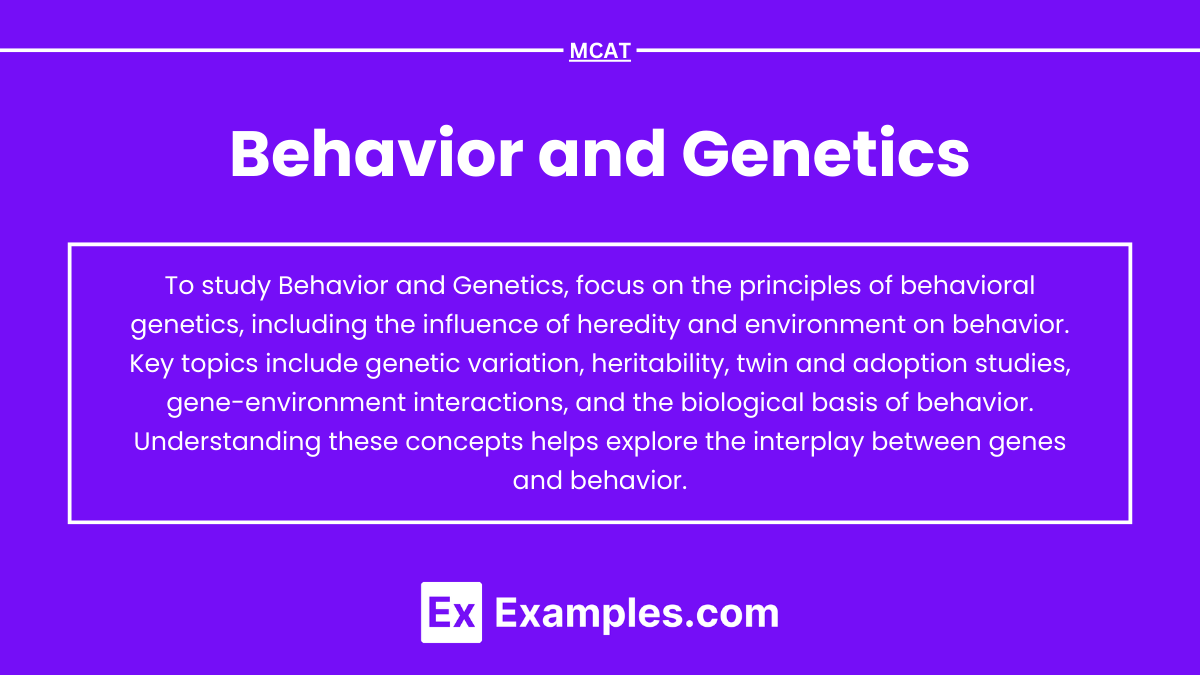“Behavior and Genetics” explores the complex interactions between genetic inheritance and environmental factors in shaping human behavior. This field examines how specific genes and biological mechanisms contribute to traits like intelligence, temperament, and mental health predispositions, while also acknowledging that environmental factors—such as upbringing, culture, and life experiences—play crucial roles. Key topics include heritability, gene-environment interactions, and epigenetics, which illustrate how behaviors result from a combination of nature and nurture. Understanding this interplay provides insights into individual differences, helping explain why people respond differently to similar experiences and how behavioral traits may be influenced by both genetic and environmental contexts.
Learning Objectives
In studying “Behavior and Genetics” for the MCAT, you should learn to understand the relationship between genetics and behavior, including how heredity and environment interact to influence traits. Explore concepts like gene-environment interaction, epigenetics, and behavioral genetics. Analyze the role of twin and adoption studies in understanding heritability. Evaluate the biological basis of behavior, including the role of neurotransmitters, brain structures, and genetic mutations. Additionally, examine genetic predispositions to mental health disorders and complex behaviors. Apply your understanding to interpreting experimental data and research findings in MCAT practice passages, focusing on how genetic and environmental factors shape behavioral outcomes.
1. Introduction to Behavioral Genetics
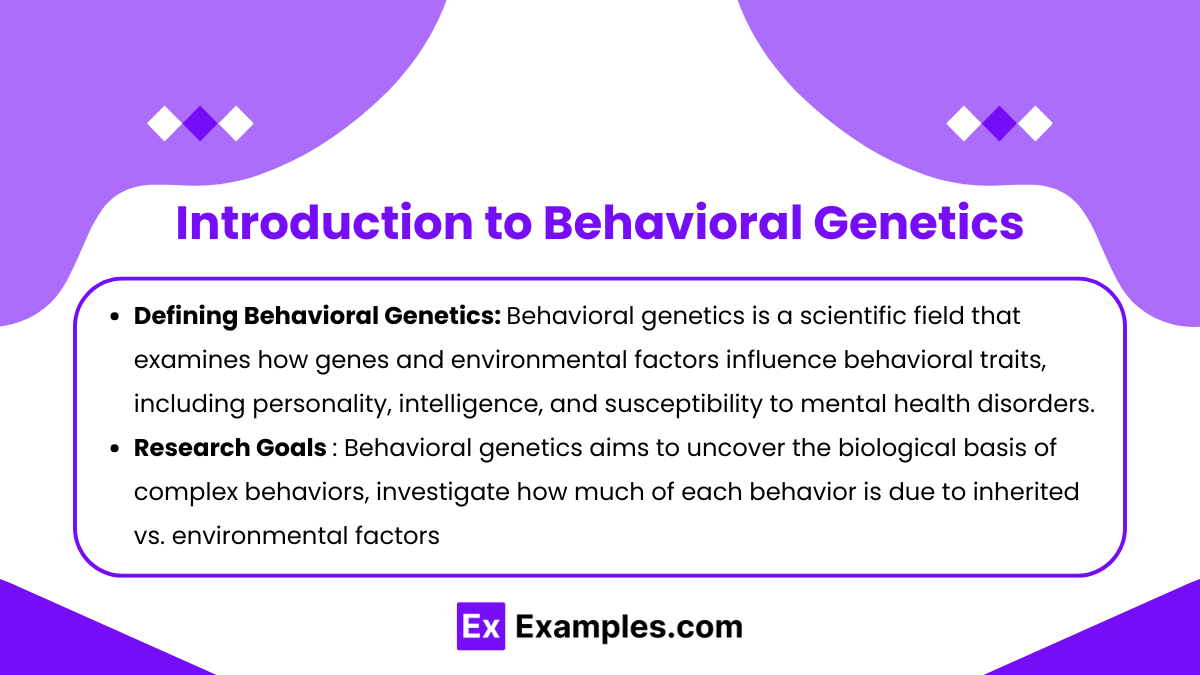
- Defining Behavioral Genetics: Behavioral genetics is a scientific field that examines how genes and environmental factors influence behavioral traits, including personality, intelligence, and susceptibility to mental health disorders. The field explores both biological mechanisms, such as the role of specific genes, and external influences, such as upbringing and cultural background, to understand how these factors shape individual differences in behavior.
- Research Goals: Behavioral genetics aims to uncover the biological basis of complex behaviors, investigate how much of each behavior is due to inherited vs. environmental factors, and determine the degree to which specific behaviors are influenced by genes and their interaction with surroundings.
2. Basic Genetics and Behavior
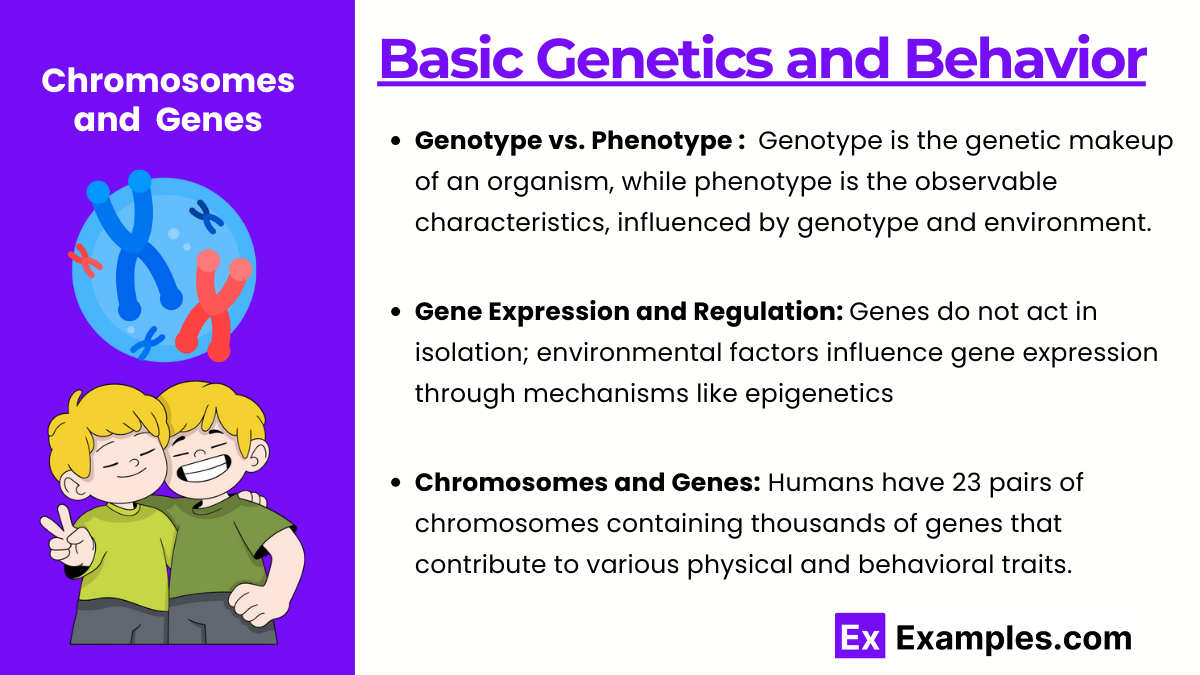
- Genotype vs. Phenotype:
- Genotype is the genetic makeup of an organism (specific alleles), while phenotype is the observable characteristics, influenced by genotype and environment.
- Gene Expression and Regulation:
- Genes do not act in isolation; environmental factors influence gene expression through mechanisms like epigenetics, where chemical modifications to DNA alter gene activity without changing the genetic code itself.
- Chromosomes and Genes: Humans have 23 pairs of chromosomes containing thousands of genes that contribute to various physical and behavioral traits.
3. Heritability and Twin Studies
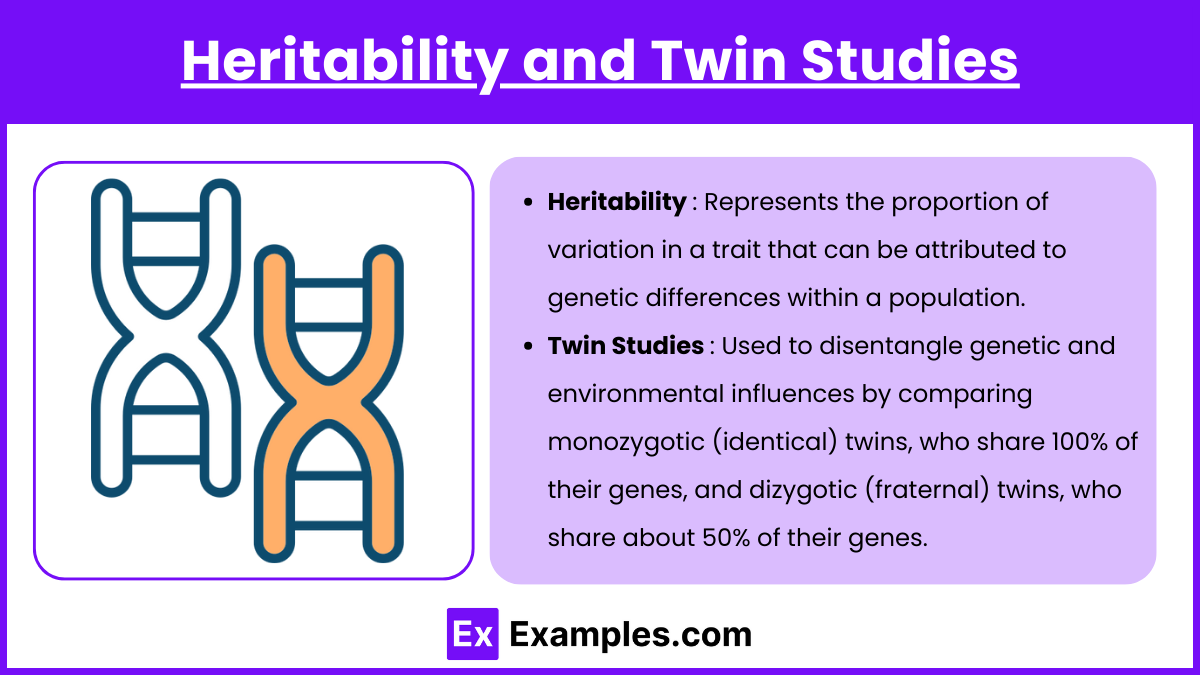
- Heritability: Represents the proportion of variation in a trait that can be attributed to genetic differences within a population. It is important to note that high heritability does not mean a trait is entirely genetically determined.
- Twin Studies: Used to disentangle genetic and environmental influences by comparing monozygotic (identical) twins, who share 100% of their genes, and dizygotic (fraternal) twins, who share about 50% of their genes.
- If a trait has a high genetic component, identical twins will show greater similarity than fraternal twins. Differences in identical twins raised apart suggest environmental influences.
4. Nature vs. Nurture Debate
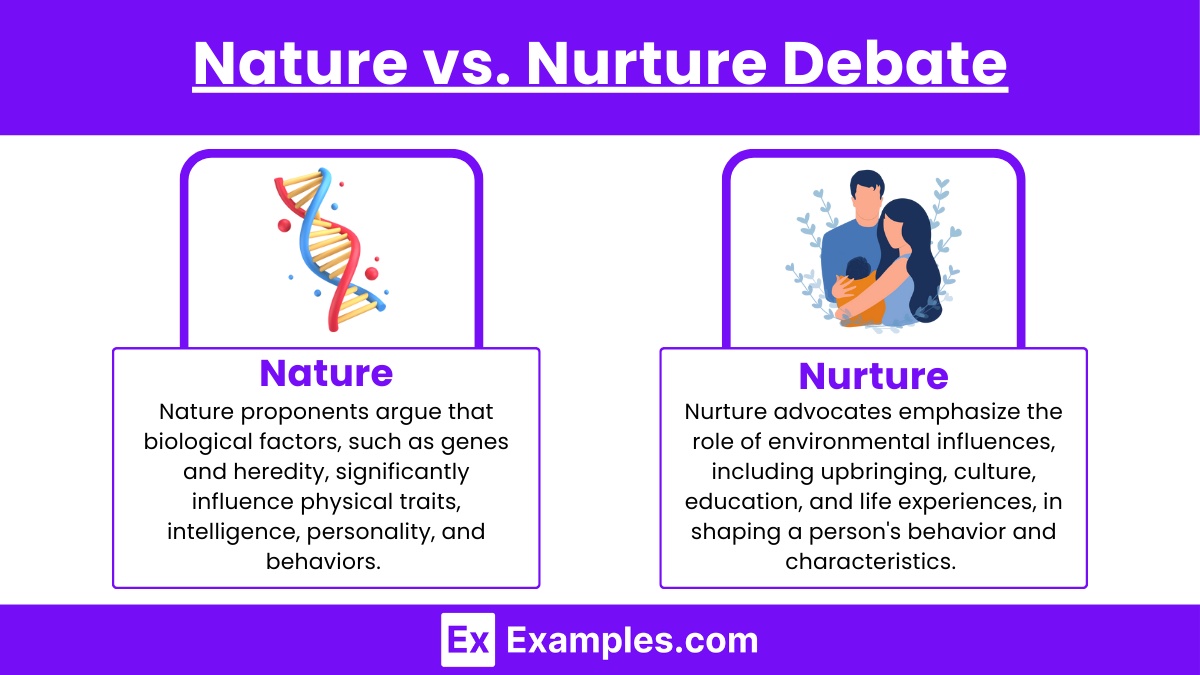
- Nature proponents argue that biological factors, such as genes and heredity, significantly influence physical traits, intelligence, personality, and behaviors. This perspective suggests that individuals are born with predetermined traits and abilities shaped by their genetic makeup.
- Nurture advocates emphasize the role of environmental influences, including upbringing, culture, education, and life experiences, in shaping a person’s behavior and characteristics. They argue that while genetic predispositions may exist, environmental factors play a crucial role in determining how these predispositions manifest and develop over time.
- The nature (genetic) vs. nurture (environmental) debate explores the extent to which behavior is shaped by genetics versus environmental factors.
- Gene-Environment Interaction: Many traits and behaviors are influenced by complex interactions between genetic predispositions and environmental factors.
- For example, a genetic predisposition to anxiety may only manifest under specific environmental stressors, demonstrating the role of both genes and environment.
5. Epigenetics
- Definition: Epigenetics involves changes in gene expression that do not involve alterations to the DNA sequence itself.
- Mechanisms:
- DNA Methylation: Addition of methyl groups to DNA, often silencing genes, thereby influencing behavior and development.
- Histone Modification: Changes in histone proteins around which DNA is wrapped, affecting gene accessibility and expression.
- Example: Early childhood trauma can lead to epigenetic changes in stress-response genes, affecting behavior and mental health later in life.
Examples
Example 1: Heritability of Intelligence
Twin studies suggest that intelligence has a significant genetic component, with heritability estimates for IQ ranging from 50% to 80%. Identical twins raised apart often display similar intelligence levels, indicating a strong genetic influence. However, environmental factors like socioeconomic status, education, and nutrition also contribute, especially in early development. This example illustrates the interplay between genetics and environment in shaping cognitive abilities.
Example 2 : Role of the MAOA Gene in Aggression
The MAOA gene, often referred to as the “warrior gene,” is involved in regulating neurotransmitters like serotonin and dopamine. Studies show that individuals with low activity in this gene variant are more prone to aggressive behavior, particularly when exposed to childhood adversity. This interaction highlights how genetic predispositions and environmental stressors can combine to influence behavior, emphasizing the gene-environment interaction in behavioral expression.
Example 3 : Genetic Influence on Mental Health Disorders
Disorders like schizophrenia and bipolar disorder have strong genetic components. For instance, schizophrenia has a heritability of approximately 80%, meaning it is significantly influenced by genetics. However, environmental triggers, such as prenatal exposure to infections or high-stress events during early development, can also play a critical role in the onset of symptoms, showing that genetics often sets the stage while the environment influences the expression of mental health disorders.
Example 4 : The Serotonin Transporter Gene and Depression
Variations in the serotonin transporter gene (5-HTTLPR) are linked to susceptibility to depression. Individuals with a certain variant of this gene are more likely to develop depression when exposed to stressful life events, such as loss or trauma. This example underscores how genetic factors can influence vulnerability to mental health conditions, with the environment acting as a potential trigger for symptom expression.
Example 5 : Alcohol Dependence and Genetic Predisposition
Studies show that there is a genetic predisposition to alcohol dependence, with heritability estimates ranging from 50% to 60%. Specific genes, like those involved in alcohol metabolism, influence a person’s likelihood of developing alcohol use disorder. However, environmental factors, including peer influence, stress, and cultural attitudes toward alcohol, also play a substantial role in the behavior’s development. This example illustrates how behavioral traits result from complex interactions between genetic predispositions and environmental influences.
Practice Questions
Question 1
Which of the following best illustrates the concept of gene-environment interaction in a microeconomic context?
A) A consumer’s preferences are entirely shaped by their genetic background, with no influence from external factors.
B) A market’s demand curve shifts only due to genetic differences among consumers.
C) A consumer has a genetic predisposition to save more, but economic conditions like inflation influence actual saving behavior.
D) A consumer’s behavior in the market is solely determined by environmental factors like income and prices.
Answer: C) A consumer has a genetic predisposition to save more, but economic conditions like inflation influence actual saving behavior.
Explanation: In behavior and genetics, gene-environment interactions occur when genetic predispositions influence behavior, but environmental factors modify or trigger these behaviors. Similarly, in microeconomics, a consumer’s natural tendency (e.g., to save more due to a genetic inclination) can be influenced by external economic conditions like inflation. While genetics provide a baseline tendency, environmental factors (inflation) can alter behavior, reflecting the interaction between intrinsic traits and external influences.
Question 2
The concept of heritability in behavioral genetics is comparable to which microeconomic concept?
A) Marginal cost, which reflects the cost added by producing one more unit.
B) Elasticity, which shows how responsive quantity demanded is to changes in price.
C) Utility maximization, where individuals seek to achieve the highest satisfaction.
D) Consumer preferences, reflecting how much of a behavior is shaped by intrinsic vs. external factors.
Answer: D) Consumer preferences, reflecting how much of a behavior is shaped by intrinsic vs. external factors.
Explanation: Heritability in behavioral genetics refers to the extent to which genetic differences contribute to individual differences in traits, paralleling how consumer preferences in microeconomics are shaped by intrinsic factors (personal values, tastes) and external factors (social influences, market trends). Just as heritability measures the genetic component of behavior, consumer preferences often reflect both inherent tendencies and environmental impacts.
Question 3
How does the concept of “risk of environmental influence” in behavioral genetics relate to economic decision-making?
A) Similar to environmental risks, consumers take all decisions in isolation without considering external factors.
B) Consumers with a predisposition to certain spending habits may change their behavior based on market trends.
C) Like genetic predispositions, market preferences remain static and unaffected by the economy.
D) Consumers always make choices based purely on utility maximization without any external influence.
Answer: B) Consumers with a predisposition to certain spending habits may change their behavior based on market trends.
Explanation: In behavioral genetics, the “risk of environmental influence” shows that while genetic predispositions exist, external influences can impact behavior. Similarly, in microeconomics, consumers may have inherent spending habits (like being frugal) but alter behavior when exposed to market trends (like an economic boom or sale season). This highlights how predispositions are flexible and can respond to environmental changes, whether in genetic behavior or economic choices.

